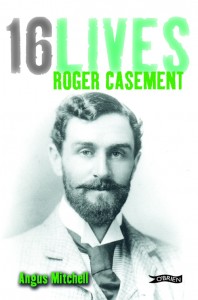16 Lives—Roger Casement
Published in Issue 3 (May/June 2014), Reviews, Volume 22ANGUS MITCHELL
O’Brien Press
£13.85
ISBN 9781847172648

Amongst the sixteen men executed after the 1916 Rising, the one whose role is most difficult to evaluate is Roger Casement. He comes across as a quixotic figure on the revolutionary margins, his importance and achievements overshadowed by controversy about the authenticity of records of his sex life that surfaced after his arrest. Yet he was the best-known public figure associated with the Rising, held to be its ringleader by John Dillon and likewise considered by British foreign secretary Sir Edward Grey as most to blame.
Angus Mitchell, who has edited documentation from Casement’s vast output, notably daily reports of his South American investigations of 1910 and 1911, aims in this very readable biography to provide a reassessment. He acknowledges that Casement’s life is both ‘extraordinary and somewhat enigmatic’. He led a partially clandestine life, as British consul in Africa watching the military and weapons movements of competing imperial powers, and later in support of Irish cultural and revolutionary nationalism. Homosexual activity would also have been clandestine.
What Mitchell brings out is how Casement’s Irish background and engagement informed his observation of colonialism in the raw in Africa and South America, and how that experience in turn sharpened his awareness of similar experiences suffered in Ireland. Like Connolly, Casement saw Ireland in a larger international framework. One British aim was to keep Ireland sequestered from the wider world. Over his career, Casement came to the conclusion that the British Empire was no better than other empires. He ended up not just an Irish revolutionary but also a whistle-blower on British foreign policy machinations. By 1916 he had few illusions about imperial Germany either, even if he felt that war blame was very one-sided.
Mitchell places Casement and allies such as E.D. Morel at the origin of a humanitarian perspective on foreign policy, including interaction with non-governmental organisations such as the Congo Reform Association. Their efforts contributed to Leopold II’s handing over of his private domain, the Congo Free State, to Belgium. Given the appalling treatment of natives, Casement was less sympathetic to Belgium in 1914. He encouraged denunciation of German atrocities in Cameroon in 1897 but, as Mitchell acknowledges elsewhere, he had a blind spot regarding genocide against the Herero tribe in German South-West Africa from 1904. Nevertheless, what he achieved won international respect and recognition, access to the US president and a knighthood.
He was part of an influential cultural, political and intellectual milieu of men and women straddling the religious divide that played a seminal role in the Revival and in the lead-up to the Rising. Casement lent their activities his prestige and his purse. Their challenge to Carsonism on the ground failed, but Casement, with German friends from his consular days and his experience of how gunrunning worked, provided a successful riposte to UVF gunrunning. The landing of arms at Howth and Kilcoole made a Rising feasible. He had several run-ins with John Redmond, who would not support the Congo cause for religious reasons; who told him that arms were the last thing the Volunteers needed; and who did not support a reprieve once shown diary extracts. Ironically, many involved in deciding Casement’s fate had been recklessly involved in backing unconsti-tutional resistance to Home Rule.
The notion of ‘gallant allies in Europe’, similar to ‘the French are on the seas’, was necessary even in tight conspiratorial circles to the credibility of a Rising. Casement embodied the German link, despite the abject failure of his attempts to form an Irish Brigade. The fact that Casement landed in Kerry trying to stop the Rising in the absence of material German aid has no decisive importance. In a letter to his cousins before his execution, he likened the Rising to a David and Goliath combat. Ireland unarmed, save with a pebble, he wrote defiantly, ‘has slain, I pray to God, the power and boast and pride of Empire. That is the achievement of the boys of 1916.’
Angus Mitchell maintains his scepticism of the ‘Black Diaries’, which are more accurately ‘Black and White’. Pornographic passages are matched by standard entries corresponding in content, though not in tone, to the ‘White Diaries’, where both are available. The inestimable value of the mixed content to Basil Thomson, head of the Special Branch, when showing selections, was that it was ‘the innocuous passages that identified the author’. No one has explained why Casement would keep a second diary covering the same events, nor the split personality and values in the parallel accounts, excluding sexual content. A US attorney, visiting Casement in Pentonville with Gavan Duffy, made him aware of what was going on and recorded Casement’s indignant disbelief of the slur. Nor did this deter him from high-minded self-vindication till his death. Additionally, few who accept the ‘Black’ content as genuine believe it to be literally credible. As the Hitler diaries show, people can go to great lengths to construct something so plausible as to take in the greatest expert. Nothing was so vital to Britain in 1916 as US entry into the war. The jury remains out on the proper interpretation of these issues. The cynical homophobic use of such material to stymie a reprieve indisputably counts as a dishonourable episode in the history of British intelligence.
















